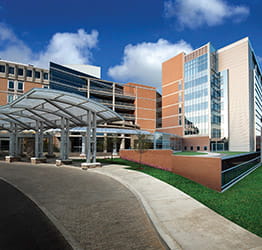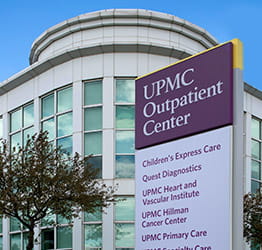On this page:
What Is Extracranial/Intracranial Vascular Disease?
Extracranial vascular disease occurs when the two sets of arteries located outside your skull that supply blood to your brain — your carotid arteries on either side of your neck and your vertebral arteries that run through your spine — become narrowed or blocked.
Intracranial vascular disease involves the arteries in your skull or at the base of your skull.
This blockage or narrowing leads to a condition called stenosis. Stenosis reduces blood flow to your brain and increases your risk of stroke, aneurysm, and other neurovascular disorders.
What are the types of extracranial/intracranial vascular disease?
Types of extracranial vascular disease
There are two types of extracranial vascular disease, depending which arteries are affected. Types include:
- Carotid artery stenosis — The arteries on either side of your neck that supply blood to the front of your brain become blocked or narrowed.
- Vertebral artery stenosis — The arteries that run through your spine and supply blood to the back of your brain become blocked or narrowed.
Types of intracranial vascular disease
Types of intracranial vascular disease include:
- Brain aneurysms — A condition that occurs when a blood vessel becomes weakened, bulges out, and eventually bursts, causing bleeding in the brain.
- Ischemic stroke — Happens when a blood vessel in your brain becomes blocked, stopping blood flow and cutting off the oxygen supply to part of your brain.
- Moyamoya disease — Causes the internal carotid arteries become narrowed and eventually close.
- Vascular malformations — Abnormal clusters of blood vessels in the brain, including arteriovenous malformations (AVMs).
What causes extracranial/intracranial vascular disease?
Atherosclerosis, which leads to the hardening and narrowing of your arteries due to fatty plaque deposits on their inner walls, is the most common cause of extracranial/intracranial vascular disease. As these plaque deposits grow larger, they can obstruct blood flow through the artery.
In rare cases, narrowing of your extracranial arteries may be caused by other conditions such as:
What are extracranial/intracranial vascular disease risk factors and complications?
Extracranial/intracranial vascular disease risk factors
You may be at increased risk of extracranial/intracranial vascular disease if you have:
Complications of extracranial/intracranial vascular disease
Left untreated, extracranial/intracranial vascular disease can cause reduced blood flow that leads to neurovascular disorders including:
These conditions can cause life-threatening complications or permanent disability.
How can I prevent extracranial/intracranial vascular disease?
You may be unable to control some of your extracranial/intracranial vascular disease risk factors, such as aging. However, preventing heart disease and chronic conditions can reduce the risk that you will develop extracranial/intracranial vascular disease. You may be able to reduce your risk by:
- Eating a diet that is rich in fruits, vegetables, and whole grains.
- Exercising and maintaining a healthy weight.
- Maintaining normal blood pressure and cholesterol levels.
- Avoiding smoking.
- Limiting alcoholic beverages.
How common is extracranial/intracranial vascular disease?
Carotid artery stenosis is the most common type of extracranial vascular disease, affecting approximately 4 percent of the population. It is more common in older adults. Ischemic stroke is the most common type of intracranial vascular disease, making up 87 percent of all strokes.
Back to top.
What Are the Signs and Symptoms of Extracranial/Intracranial Vascular Disease?
Symptoms of extracranial/intracranial vascular disease may vary depending on which arteries are affected. In some cases, your condition may not cause symptoms until a complication — such as a TIA, stroke, or aneurysm — occurs.
Symptoms of a TIA or stroke
Extracranial/intracranial vascular disease can cause a stroke or a TIA. A TIA, sometimes called a “mini-stroke,” often warns that a stroke will happen soon. Symptoms of a TIA or stroke include:
- Changes in vision.
- Difficulty speaking or understanding speech.
- Sudden, severe headache.
- Weakness or numbness on one side of the body.
Symptoms of extracranial/intracranial vascular disease
Symptoms of extracranial/intracranial vascular disease may include:
- Difficulty speaking.
- Dizziness.
- Double vision.
- Vertigo.
- Numbness around your mouth.
- Partial blindness.
- Tinnitus (ringing in the ears).
When should I see a doctor about my extracranial/intracranial vascular disease symptoms?
If you have symptoms of extracranial/intracranial vascular disease or stroke, you should seek emergency treatment by dialing 911 right away — don’t wait. Often, extracranial vascular disease doesn’t cause symptoms until a serious complication such as stroke or aneurysm occurs.
Back to top.
How Do You Diagnose Extracranial/Intracranial Vascular Disease?
To diagnose extracranial/intracranial vascular disease, your doctor will perform a physical exam and order imaging tests.
What to expect during your visit
When you arrive at the hospital or doctor’s office, your doctor will:
- Ask about your medical and family history.
- Perform a full physical exam.
- Perform several imaging tests.
Tests to diagnose extracranial/intracranial vascular disease
Your doctor may request imaging tests to examine how blood flows through your arteries. These diagnostic tests include:
- CT or MR angiogram — Also known as arteriography or an arteriogram, this test uses x-rays or magnets and a special contrast dye to look for problems with the blood vessels in your brain.
- CT scan — A test that creates images of your brain and is used to diagnose stroke, brain aneurysm, or another type of brain injury.
- Doppler ultrasound — A noninvasive test that uses ultrasound waves to measure blood flow through your arteries and veins.
- MRI — Uses a combination of large magnets, radio frequencies, and a computer to produce detailed images of your brain.
Extracranial/intracranial vascular disease prognosis
Extracranial/intracranial vascular disease can be a life-threatening condition. Your prognosis will depend on the severity of the narrowing or blockage, what symptoms you have, and how quickly you receive medical care.
Back to top.
How Do You Treat Extracranial/Intracranial Vascular Disease?
The goal of extracranial/intracranial vascular disease treatment is to restore blood flow to your brain and reduce the risk of stroke and other complications.
UPMC’s neurovascular experts take a multidisciplinary approach to treating extracranial/intracranial vascular disease. Your team of neurosurgeons, neurologists, cardiologists, radiologists, and other medical experts will recommend the treatment or combination of treatments that will provide effective care with the lowest risk of complications, giving you the best chance of recovery.
Recommended treatment options for extracranial/intracranial vascular disease depend on:
- The location of the blockage or narrowing.
- The severity of your symptoms.
- Your age and medical history.
Your treatment plan may include:
Lifestyle changes
If you do not have any symptoms and you have a low risk of stroke, your doctor may recommend lifestyle changes to control the factors that contribute to plaque build-up in your carotid and vertebral arteries.
Lifestyle changes include:
- Controlling blood sugar if you have diabetes.
- Decreasing LDL (bad) cholesterol levels in your blood and increasing HDL (good) cholesterol levels.
- Eating a heart-healthy diet.
- Exercising.
- Limiting alcohol intake.
- Losing weight.
- Lowering blood pressure.
- Quitting smoking.
Medicine to treat extracranial/intracranial vascular disease
Medication can help you manage other health conditions contributing to extracranial/intracranial vascular disease. Medications your doctor may prescribe include:
- Antiplatelet medications, such as aspirin and clopidogrel.
- Blood pressure medications, such as diuretics and beta blockers.
- Blood-thinners (anticoagulants), such as warfarin.
- Statins to control cholesterol levels.
Carotid endarterectomy for extracranial/intracranial vascular disease
Carotid endarterectomy is the standard treatment for carotid artery disease.
This surgical procedure allows your surgeon to remove the inner lining of your carotid artery that contains the plaque through a small incision in your neck.
If you need a carotid endarterectomy, UPMC vascular surgeons have performed thousands of these procedures. We generally discharge most patients the day after the procedure, with little risk for long-term complications.
Angioplasty and stenting
Angioplasty and stenting is a minimally invasive procedure that your surgeon may recommend if complete blockage or narrowing of your artery occurs. It allows your surgeon to use x-ray imaging to guide a balloon-tipped catheter to the blockage.
During this procedure, your surgeon will:
- Insert a small, thin tube called a catheter through a small incision in your groin. The catheter has a balloon at the tip.
- Use x-ray imaging to guide the catheter to the site of the blockage.
- Inflate the balloon at the tip of the catheter to flatten the plaque and open the artery.
- Place a small metal tube called a stent to help open your artery.
Transcarotid artery revascularization (TCAR)
TCAR is a minimally invasive procedure to open a blocked carotid artery. During the procedure, your surgeon will:
- Make an incision in your neck.
- Insert a balloon-tipped catheter into your carotid artery.
- Temporarily reverse blood flow away from your brain. This reduces the risk of a piece of plaque traveling to your brain, blocking an artery, and causing a stroke.
- Inflate the balloon at the end of the catheter to flatten the plaque and open your artery.
Why choose UPMC for extracranial/intracranial vascular disease care?
When you choose UPMC for extracranial/intracranial vascular disease care, you will receive:
- Access to world-class neurosurgery expertise — Our world-renowned experts treat the full spectrum of neurosurgical conditions using the latest diagnostic and treatment techniques.
- A full range of treatment options — We offer nonsurgical care, as well as minimally invasive and traditional open surgical procedures, allowing us to effectively treat all types of disorders while reducing your risk of complications.
- Multidisciplinary care — We partner with neurologists, rehabilitation specialists, and other medical experts to provide complete care that optimizes your recovery and quality of life.
Back to top.
By UPMC Editorial Staff. Last reviewed on 2025-02-17.
















